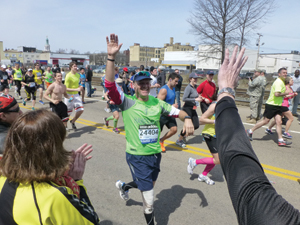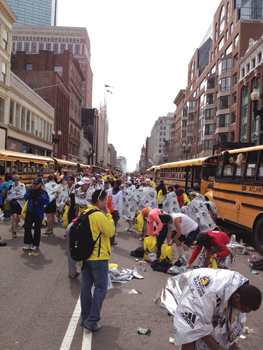Numerous executives within the sports industry were on-site when tragedy struck the Boston Marathon. SBJ/SBD gathered some of their personal stories from those horrible moments. For more from these accounts and others, see www.sportsbusinessjournal.com.
Tim Hawes
Senior Vice President, Retail Licensing
PGA Tour
It was a horrific ending to an epic day. I was running in my first Boston Marathon with a charity team, “Golf Fights Cancer.” I was running along Commonwealth Avenue, about 3/10 of a mile from the finish line. All of a sudden, all the runners just came to an immediate stop. When you’re running, you’re in a bit of a daze, you’re not really paying attention to your surroundings. As I looked up the road, there was a mass of people just standing there. I was about 50 feet back from where Boston police had blocked off the road.
All the runners were in this state of confusion. We were all looking around, wondering what in the world had happened, why have we stopped. Within a minute or two, word began to circulate that there had been explosions at the finish line. One person said a boiler in one of the hotels had blown up. We didn’t know. We were literally close enough to see the finish line, way down the street and around the corner. That’s when this annoyance and confusion and anger turned into a unique combination of panic and camaraderie. People who had been agitated went for their cell phones, those that had them. I did not have my phone, so another runner offered to use his phone.
My wife and I had pre-arranged a spot down the course from the finish line to meet, so I took some comfort that she wouldn’t have been at the finish line. Still, I was absolutely panicked because I couldn’t get in touch with her.
The police kept us there, I don’t know, 30 to 45 minutes. They just said to stay where we were. There was this wonderful sense of camaraderie because it was 48 degrees, you go from sweating to shivering and cold, and people start bringing garbage bags to allow runners to put the bag over them for insulation. People brought water and food. As you looked around, people were having panic attacks and getting ill. At one point, this solid line of ambulances, fire trucks and police cars went by us going 50-60 mph down a city street. I thought at one point that I had seen 150 ambulances. Everybody knew it was a really serious problem. Runners were trying to console each other.
Universal Sports scrambles after live coverage ends
Universal Sports CEO David Sternberg was at Boston’s Logan Airport, leaving the city, when the bombs that disrupted the Boston Marathon went off.
The channel holds the national TV rights for the race and had stopped its coverage of the event at 1 p.m. ET, when the elite runners had finished. When the bombs went off, at around 2:50 p.m., Universal Sports producers were mapping out the network’s wrap-up show, which was scheduled to start at 4 p.m. from the channel’s Copley Square set.
“We knew pretty quickly that we couldn’t do the 4 p.m. show because Copley Square was a triage area,” Sternberg said.
After frantically making calls to make sure all of the channel’s employees in the area were safe (they were), Sternberg huddled with the network’s head of programming, Bob James, to talk about the re-air of the race that was planned for that night.
“We both concurred immediately that it would be insensitive to replay the race in prime time as if nothing had happened,” Sternberg said. “We checked also with our sponsors and advertisers, and nobody disagreed with that decision.”
Sternberg said the bombing would not change how the channel covers these types of open-air events.
“The production area and the set we built over at Copley Square were all in secure areas,” he said. “Organizers may change their approach in the future to access, generally, and that could have an impact on how close we’re able to get to the finish-line areas or athletes.
Hopefully, that’s something that will be worked out by all these events in consultation with their broadcast partners.”
— John Ourand
After being held in that area for 45 minutes or so, police said the race is over, you’re done, go around to the finish line down an alternate street. We all cooperatively headed that way to get to the busses, where all of our gear was. The first thing I did was get out my phone and text my wife. “Are you there,” I wrote. She immediately texted back, “Yes.” It was a pretty incredible moment. We met at a spot in the family meeting area and walked back to the hotel. I was so cold. Some of the volunteers came with thermal blankets. As I checked my phone, I had 117 emails and 70 text messages. Just about everyone I know was checking on me. That was pretty overwhelming.
This was my first Boston Marathon. Unfortunately, I was stopped 3/10 of a mile short, but in the grand scheme of things, that’s pretty insignificant. The race for 25.9 miles exceeded every expectation. I’ve run marathons and half marathons, and this was the pinnacle. One thing I keep thinking about is the three or four minutes I stopped, around the 10-mile mark, and took a few pictures with some friends who were cheering me on. If not for that three or four minutes I stopped, I would have been right in the middle of all the chaos at the finish line. I’ve played that over in my mind about 2,000 times.
***
Mary Wittenberg
CEO
New York Road Runners
I had spent the day watching from a variety of places, and I was at the finish line for about an hour to watch (1984 Olympic Marathon champion) Joan Benoit finish. I was enjoying the sunshine and watching these runners. Coming off our marathon, it was so good to be back in that environment, to have that feeling of shared camaraderie. I remember looking out at the finish line and thinking, “Wow, this is a lot of spectators.” I was with Josh Rowe from New Balance and a few of our staff, we were across the street from where the second bomb went off.
So after Joan finished in 2:52, which was just 30 minutes from her run 30 years ago, and she’s 52, we had some great photos at the finish line. As I often do with Boston, I jumped on the 1:15 p.m. train back to New York because I had to leave for London. About an hour into the train ride I get this text from Josh saying, “Our greatest nightmare has happened. Two explosions at the finish line.” At the same moment I started getting texts from friends in New York asking if I was OK. It was a shock. We spent the rest of the train ride checking in on a lot of people.
We got off the train in New York and WNBC was there, and after the interview we went to the office and just started checking in on people to make sure they were OK. We had 22 employees at the event. Then we checked with (Boston Athletic Association) folks. Then it’s members of the club who were running in Boston. Boston is such a goal and an aspiration for so many runners. All the way I was trying to just process everything. I spent the rest of the night getting our statement out — I didn’t want to talk to a lot of media, I just wanted to share our thoughts and prayers with Boston.
I got home and got big hugs from the family, and just spent time with them. The kids absorb this stuff, they are old enough to know what went on. I wanted to make sure they were OK. Then I just took it in, it was a restless night.
***
Bruce Revman
Senior Vice President, Marketing
The Competitor Group
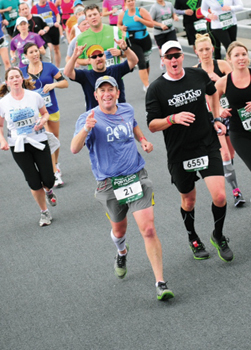 |
Revman, shown here in a Portland race, was across the street from the first blast.
|
I’m from Boston and I’ve been to the last 35 Boston marathons, either as a runner or a spectator. I grew up around that race and I know what Patriots’ Day is all about. It’s the best day of the year. And now the running industry meets there, so if you work in the industry you have to be there. My daughter goes to school at Wellesley College in Cambridge, and she came to the race with a friend. We were across the street from where the bomb went off in the bleacher in the VIP area.
We were departing the stands when the bomb exploded. It sounded like the musket rifle they shoot in the air to reenact Patriots’ Day. It’s so noisy at the finish line, so it wasn’t as loud to me, so I didn’t know something was wrong until I saw people running toward the explosion. The first responders started running through the crowd like fullbacks. It was impressive.
I personally never felt like I was in danger, but I had the responsibility with my daughter and her friend to get her home. We walked five miles from the Back Bay to Cambridge because the subway was closed.
I’ve had this hangover from the whole thing. I’m very bothered. I’m very much in a cloud these days, like I missed my exit on the freeway because I was daydreaming. It’s surreal to see the marathon in this way. Combining the Boston Marathon with the term “bombing” doesn’t correlate with me right now.
***
Tom Beusse
President
USA Today Sports Media Group
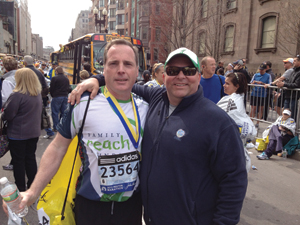 |
Beusse (left) with friend Ed Lynch
|
I had just finished the race about 4 minutes prior. I was walking through post-race corrals toward my medal and some food, about 100 yards or so away, when the blast occurred. The scene went from beautiful to tragic instantly. The police and volunteers secured the scene quickly and steered the runners and spectators out of harms way. Hats off to all of them. I saw volunteers climbing over fences to get to the bomb site and help the injured without any regard for their own safety. It was selfless and inspiring.
Sports is at its best at marathons, I think. Most
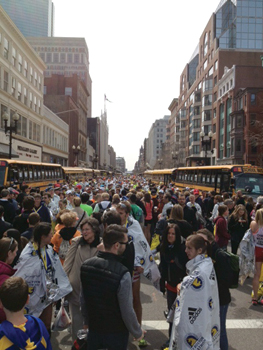 |
Beusse provided a photo before the explosions (above) and after, with smoke visible in the distance (below).
|
of the runners are raising money for a cause. People having a purpose. I hope that the many international participants and spectators bring this story home with them and share our grief and our anger. We must all stand defiantly against this cowardly act and others like it.
Runners are a fiercely committed community. I have no doubt the Boston Marathon will be no less epic next year than in any of its 117 years. People will enter and run for the causes they care most about. Hopefully the weather will, again, be as beautiful as ours was Monday. But next year, hopefully the ending will be about personal bests and accomplishments rather than about human tragedies.
***
Jim McCloud
Vice President of Sponsorship Sales
MLB Advanced Media
I’m from Boston originally and this was my fourth marathon. I finished about 20 minutes prior to everything. I was one street over at Copley — almost even with where the bomb was — when everything happened. At first I was like, “Holy shit. What was that?” Then it was like the running of the bulls. People were running everywhere. I called my wife and said something had happened and made sure she knew I was fine before cell service went out. I didn’t know what had happened, so I just kept walking and walked three or four miles. It was weird. You couldn’t see smoke or anything when the bomb went off. The ground just shook and it was loud. The guys at Fenway told me to come over there, but I said, “I’m not going over there. I’m getting the hell out of Boston.”
Being from the area, it’s one of those things that hits close to home. It could have easily been me or some of my loved ones. I’ll never forget what it sounded like. I don’t know what a sophisticated bomb sounds like but that was loud. The image of people running down the street in complete chaos will be a lasting image. Next year’s marathon will be extra special. I won’t miss it for the world.
***
Brennan Feldhausen
Corporate Partnerships Account Manager
Baltimore Orioles
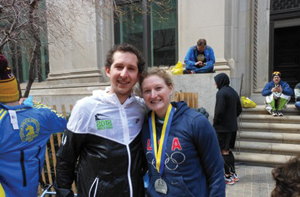 |
Feldhausen and his sister, Trisha, who also ran the race, finished before the bombs exploded.
|
I was below ground attempting to get on the T when the explosion took place. We weren’t able to get on the first train that came because it was full of people (primarily runners and fans). We waited for another train and got on. Prior to it leaving the station we were informed that the station was closing and that the train (and station) had to be evacuated. The crowd was calm and cooperative. Once we made our way to ground level we saw several police and emergency vehicles. Shortly thereafter we received a bunch of texts, calls, emails from friends and family both in Boston and around the country. I was staying up to date on the situation through Twitter as we made the walk to our hotel about two to three miles away.
I was very impressed with how the extremely unfortunate situation was handled. Information was available via social media very quickly. Runners were very cooperative and understanding. Having spent some time in the med tent after my race I was impressed by how they had everything so well organized. Based off of this, I am not surprised with how quickly they responded to the needs of those affected by the explosions just before the finish line. There were many police and medical personal that helped out quickly in large part because of their proximity to the incident. I am proud of the way that the running community has come together — both at the initial time of need and over the past 24 hours.
***
Brian Oates
Executive Sales Director
New England Patriots
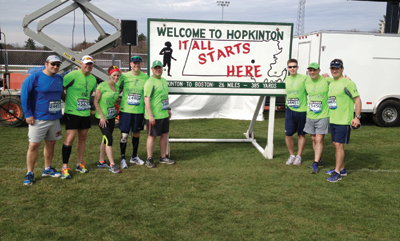 |
Oates (second from right) with his Team Golf Fights Cancer crew, which includes the PGA Tour’s Tim Hawes (fourth from left), MLBAM’s Jim McCloud (third from right) and, not pictured, Shaina “Shay” Aviles of the PGA Tour.
|
I was about 100 yards past the finish line — getting a blanket and picking up my medal when the bombs went off. When the first bomb went off, I turned around, and looking at the thick, white smoke, my first instinct was dread. I hoped that it was perhaps some sort of accident, like a transformer blowing or underground explosion, but when the second bomb exploded, I knew that something was seriously wrong.
I think the situation, tragic as it is, was handled incredibly well. It was both amazing and chilling to see
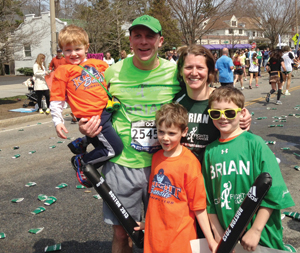 |
Brian Oates and family along the race route.
|
Boston police and marathon organizers racing into the danger, swimming upstream against a steady current of bewildered runners in the chute, to try and address the situation and bring care to the injured. I have participated in the last 17 Boston Marathons — never have I felt unsafe. The organizers are best in class and I know that runner safety and event security are two key critical success factors for the event. The organizers and the volunteers of the BAA are committed, compassionate and are off the charts prepared, which makes this incident all the more tragic.
Turning onto Boylston Street as a marathoner is one of the most exhilarating feelings that regular Joe athletes can experience. I am sad, and it’s a shame that experience was denied to so many this year and changed forevermore for everyone else. That said, I am not going to let “them” win. I am going to focus on the countless acts of inspiration, generosity and courage that characterize the marathon and the many that are involved running, fundraising, organizing and supporting the event, and not the cowardice and hate of terrorists.
— Compiled by Theresa Manahan, Michael Smith, Fred Dreier and Tripp Mickle
An unexpected call, a frightened whisper
SBJ/SBD had a personal connection to last Monday’s tragedy at the Boston Marathon: Megan Lombardo, 47, of Winnetka, Ill., and wife of SBJ staff writer John Lombardo, finished the race not long before the bombs went off. We asked John to reflect on that afternoon.
You fly into New York, and perhaps you think about it for a split second as you swoop over lower Manhattan on final approach to LaGuardia Airport. You sit in a crowded movie theater, or pass by a grammar school, and maybe it crosses your mind.
But you don’t think about it on a mid-April afternoon in a Chicago office as you wait for your wife to call to share her joy minutes after she has run the Boston Marathon.
So when my phone blinked last Monday with my wife Megan’s cell number around 2 p.m. Chicago time, I was eager to hear of Hopkinton, of Heartbreak Hill and of satisfaction from someone who had spent the past four months trudging out of the house at 5 a.m. to train in the misery of a Chicago winter for her moment of glory in Boston.
What I got was none of that.
“I am locked in bathroom with other people and there has been a bombing or maybe someone is shooting and I’m scared and I …”
And the call dropped.
A frightened and confused whisper — and then nothing.
Stunned by the sound of terror instead of triumph, I dialed and texted Megan back but with no response. I jumped online, but the unfolding tragedy was still too fresh to have hit the wires or even social media.
A few calls and texts streamed in to me, with people innocently asking about times and splits and details — not just of Megan’s race, but of another family member and other friends who also ran the marathon.
Minutes later, I saw the crawl over the Boston Globe’s website that there was an explosion at the race.
My first reaction in those early moments of confusion, admittedly, was relief. Odd as that is to write now (knowing all that we do about the tragedy), in that instance, I figured Megan was actually safe — because I had talked to her after she had heard whatever those explosions were. Disbelief then set in, followed soon after by horror, as reports from the scene started to come in.
Twenty minutes later, Megan called back and got through. Breathlessly, she told me how she and her friend along with eight other strangers were near the finish line at the time of the blasts and had taken cover in a bathroom at the back of a store. After what seemed to be an eternity but was probably 10 minutes, they were guided out of the chaos.
All were scared, but all were fine. Others weren’t so lucky; that was immediately clear. And we both felt the fear on the phone.
School for my two kids ended at 2:45. My 11-year-old daughter called to say she was going to a friend’s house. I told her that her mom had run a great race and was fine.
“Tell her I said hi,” my daughter said, blissfully unaware of the violence that barely had missed her mother.
My 13-year-old daughter knew. Like a lot of other teenagers, she flicked on her iPhone the second school ended. She had heard the news before I could get to her, and had already texted Megan: “Did U get hit by the bomb?”
After an assurance in response that she was OK, and a brief statement later to an FBI agent at Logan Airport, Megan boarded a plane and headed for home. She arrived back at our suburban Chicago house at 11:30.
The kids were asleep, but Megan lingered a bit in their bedroom doorway.


